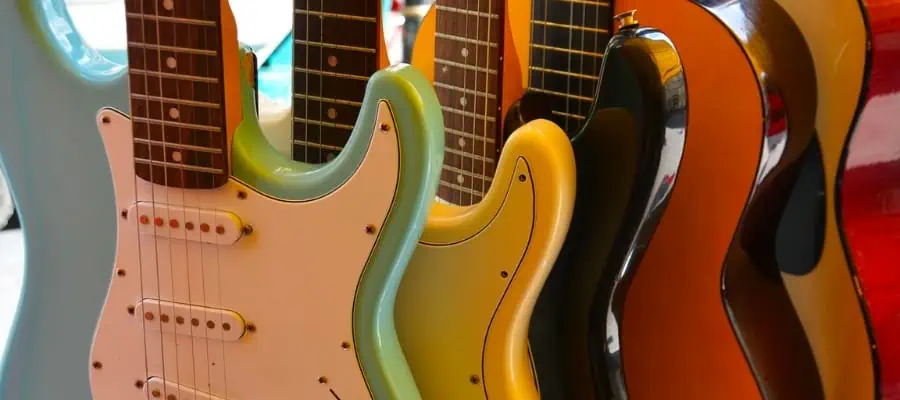Guitars resonate with music enthusiasts worldwide, but have you ever wondered what’s up with that hollow space inside? It’s not just for show – that hollow air chamber plays a crucial role in the sound of the guitar.,
Guitars have a hollow air chamber to amplify the strings’ vibrations, which increases the volume and enriches the sound. The shape and wood of the chamber enhance specific frequencies, while the sound hole projects the sound outward. A guitar would produce a much quieter and more resonant sound with this chamber.
Ever notice how different guitar shapes and sizes produce different sounds? That’s the air chamber working its magic. Smaller chambers generally lead to a brighter, more treble-focused sound. On the other hand, a bigger body with a larger air chamber usually yields a warmer and bassier tone.
Next time you pick up a guitar, remember it’s not just about the strings or the pick – that hollow air chamber has much to do with your music.
The Fundamentals of Guitar Acoustics

Before diving into specifics, know that the hollow air chamber in your guitar plays a critical role in shaping the sound that delights your ears, converting string vibrations into audible tones.
The Role of the Hollow Air Chamber
The hollow air chamber of a guitar is the heart of the instrument’s acoustic design. When you pluck a string, you create vibrations. These vibrations need somewhere to go, and that’s where the air chamber comes in. It’s like the lungs of your guitar – with each vibration, the guitar body breathes life into the sound.
Think of the air chamber as a sound expansion pack. It takes the initial energy from the vibrating strings and amplifies it in three significant ways:
- Boosting Amplitude: The chamber increases the loudness of the sound.
- Enhancing Tone: It enriches the quality of the sound, contributing to a fuller and warmer tone.
- Sustaining Resonance: This cavity helps sustain vibration, letting notes hold and fade naturally.
Sound Production and Resonance
As soon as you strike a string, you’re not just hearing a string twang but witnessing a symphony of acoustics at work. The string’s vibrations transfer to the soundboard, which is the top of the body, usually featuring the soundhole. This flat surface acts as an amplifier. It’s like throwing a rock in a pond; the sound waves ripple outward through the air.
Here’s where it gets cool:
- Frequency & Pitch: Different frequencies produced give each note its unique pitch. Tightening or loosening the strings changes these frequencies, shifting the pitch.
- Resonance Inside the Body: Inside the hollow chamber, the sound waves bounce around, adding to and reinforcing the vibrations of the strings. This interaction creates resonance—a sustainable and enriching echo that defines a guitar’s character.
- Vibration Through the Air: Resonance doesn’t just stick inside; it spreads through the soundhole. Essentially, the guitar’s insides are conversing with the outside world. The result? The sweet, rich sound you love.
By understanding how an air chamber affects your guitar’s sound production, you gain a greater appreciation for the craftsmanship behind every strum.
Acoustic vs. Electric: Sound Mechanisms Compared

The way the string vibrations turn into the sound that reaches your ears differs significantly between the two types.
Acoustic Guitar Body Dynamics
Your acoustic guitar is designed like a natural amplifier. It has a sound hole and a hollow chamber that enhances the sound of the strings vibrating. When you strike a string, the vibrations transfer to the guitar’s top, also known as the soundboard, via the bridge.
The soundboard amplifies these vibrations inside the hollow air chamber, creating a richer and more resonant sound that emerges through the sound hole.
- Vibration Transfer: String → Bridge → Soundboard
- Amplification: Hollow chamber
- Sound Projection: Soundhole
Electric Guitar Amplification
In contrast, most electric guitars do not rely on a hollow chamber for sound amplification. These electric guitars are called solid-body electric guitars. They use magnetic pickups that are positioned under the strings. When you play, the string vibrations disturb the magnetic field around these pickups, creating an electrical signal. This signal travels through your guitar’s circuitry to an amplifier, which converts it into audible sound.
- Vibration Capture: Magnetic pickups
- Signal Path: Guitar’s circuitry → Amplifier
- Sound Production: Amplified electrical signal
With solid-body electric guitars, body shape, and size don’t affect the sound as much, allowing for various guitar designs that can still produce quality audio output when connected to an amplifier.
But there are also hollow-body and semi-hollow-body electric guitars, which act as acoustic and electric guitars.
Hollow-body electric guitars come with an air chamber, often featuring a carved or laminated top and back with f-shaped holes. The side parts are attached to the top and back and are bent into shape, which creates the air chamber.
Semi-hollow-body guitars are just like hollow-body guitars, but they feature a solid block of wood running through the length of the body. This way, they sound and function somewhere between the solid and hollow-body guitars.
Design and Variations of Sound Holes

Guitar sound holes come in various shapes and sizes, impacting the guitar’s voice.
Standard Round Soundholes
The classic round hole is a staple for many acoustic guitars. You’ll find this type of sound hole center stage on the body beneath the strings. It works like a speaker, projecting sound waves outward and allowing the guitar’s top to vibrate freely. This design yields a balanced tone with a strong projection favored in many music genres.
- Purpose: Projection of sound vibration of the guitar’s top
- Shape: Circular
- Position: Centered beneath the strings
F-Holes and Alternative Designs
F-holes are different from the standard design, famously used in violins, violas, and many archtop guitars. They are f-shaped cuts on the instrument’s top and are known for providing a different resonant quality, often described as more focused and punchier than the round sound hole.
- F-holes:
- Purpose: Enhanced sound projection altered tonal characteristics
- Shape: F-shaped
- Position: Usually found on the upper body of the instrument
You might see an oval hole for nylon string and flamenco guitars, which gives a particularly crisp sound suited to the styles associated with these guitars. Other guitars might feature multiple smaller holes positioned around the guitar’s top, distributing the sound differently from the traditional central sound hole.
- Other Designs:
- Oval Hole:
- Purpose: Crisp sound characteristic.
- Shape: Oval.
- Multiple Smaller Holes:
- Purpose: Unique distribution of sound.
- Shape: Varies in size and form.
- Oval Hole:
Practical Considerations in Guitar Design

When you’re thinking about guitar design, there’s a balance of aesthetic beauty and acoustic functionality that you have to keep in mind.
Impact on Tone and Volume
Tonewoods play a crucial role in defining a guitar’s sustain, noise, and volume. Different woods contribute to the instrument’s unique sound profile; for example, mahogany emphasizes warmth, while maple can enhance brightness. Gibson often uses mahogany in both the neck and body for its Les Paul models, impacting the rich tones it’s known for.
Like their famous Stratocaster and Telecaster, Guitars from Fender typically feature ash or alder bodies, which are preferred for their bright, full sounds. These woods affect the tone and interact with the guitar’s bridge and neck to influence the overall volume and sustain.
Materials and Construction
The bracing pattern inside the guitar’s hollow body strengthens and adjusts the sound. For example, Martin guitars often use an “X” bracing that’s credited with providing excellent resonance and volume transfer from the top of the guitar.
In contrast to traditional designs, Ovation uses a composite for the back of its guitars, making them distinctive regarding resilience and how they project sound. Unique materials like these contribute to the instrument’s physical durability and acoustic properties.
Construction methods vary between manufacturers: Gretsch, PRS, Godin, and others have signature traits in their assembly processes that influence their instruments’ playability and sound. These variations include how the neck joins the body or using certain tonewoods and bracing patterns, all practical considerations with essential implications for the player.
Conclusion
You’ve seen how the hollow air chamber in a guitar is essential for its function.
- The Air Chamber’s Role: It amplifies the vibrations from the strings.
- Sound Quality: The shape and size of this chamber affect the tone and volume.
- Material Matters: Different woods offer unique sounds, impacting the guitar’s character.
Remember, this clever design allows you to fill a room with music without needing any electronic help. Keep these points in mind next time you pick up a guitar and appreciate the craftsmanship that goes into creating that perfect sound.

Recent Posts
Tuning your guitar to E Flat, also known as E♭ tuning or half-step-down tuning, involves lowering each string by a half step. This creates the notes E♭, A♭, D♭, G♭, B♭, E♭ or D#, G#,...
50 Campfire Guitar Songs To Ignite Your Next Singalong - Chords Included
Gathering around a crackling campfire with friends and a guitar is one of life's simpleest pleasures. Picture yourself strumming the chords as everyone belts out the chorus under a starry sky. From...

